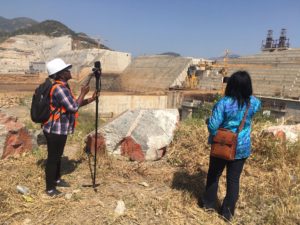By Gabrielle Nina Mitch
Statistics show that Ethiopia would undoubtedly be amongst countries to have experienced amazing growth in recent years. Its estimated GDP of 8.3% in 2017 is three times higher than the world average of 2.7% in the last year, says the World Bank.
Although modern infrastructures have been sprouting up across the landscape, it is coming at a cost which the country’s leadership is willing to bear. The reason for this is not far-fetched pundits say unlike most African countries, Ethiopia is not immune to energy difficulties and experts have argued that economic growth would only be sustainable if electricity problems are put to rest.
The Renaissance
Barely 15% of Ethiopians have access to electricity and the government seems determined to overcome this challenge. In 2011, the government launched a project to build a gigantic hydroelectric dam dubbed the “Renaissance”.
The project is one of the flagship projects of the African Union and New Partnership for Africa’s Development (NEPAD) developed within the framework of the Program for Infrastructure and Development in Africa (PIDA). The huge Dam stands in the heart of the continent on the bed of the Nile River, a foremost water resource for the majority of African countries.
An extraordinary funding model
The cost of the project is estimated at 3.4 billion Euros, financed entirely by the Ethiopian government and the Ethiopians themselves from the country and the diaspora.
Speaking to the Deputy Project Manager of the Reinassance Dam Ephrem Wikidan explains the funding structure “Ethiopians have so far contributed around $460 million towards the construction of the Dam, through various schemes including grants, bond sales, athletic events and lottery draws. of the total, $4.9 million was from Ethiopians and foreign nationals of Ethiopian origin in the diaspora.

Unlike other African countries that receive external assistance to implement sometimes inferior projects, Ethiopia has challenged itself to secure this funding after a total withdrawal of foreign investors following diplomatic conflict around the Nile between Sudan, Ethiopia, and Egypt.
Some of these countries, whose water supply is 90% Nile, feared that the Renaissance dam project would deprive the country of part of its water.
Historic Electric Power
The project is located in the state of Benishangul, a province Northern Ethiopia, 500 km from the capital city Addis Ababa, with the Blue Nile, one of the largest tributary of the Nile, winding between the highlands mountains, 20 km from the border with Sudan.
The project’s Pharaonic dimensions of 1,800 m long, 155 m high and a total volume of 74,000 million m³, will be composed of two power plants installed at the foot of the dam.
 Also, the project will have a total of 16 turbines with an installed capacity of 6,000 MW and an estimated production of 15,000 KWh per year. The reservoir area will be about 1700 km2 and the can retain about 74 million cubic meters of Water which is even more than the annual capacity of the Nile. This will make the Great Renaissance, the largest dam in Africa once the work is completed.
Also, the project will have a total of 16 turbines with an installed capacity of 6,000 MW and an estimated production of 15,000 KWh per year. The reservoir area will be about 1700 km2 and the can retain about 74 million cubic meters of Water which is even more than the annual capacity of the Nile. This will make the Great Renaissance, the largest dam in Africa once the work is completed.
The Ethiopian Grand Renaissance dam will produce reliable, stable and sustainable electricity and the cheapest in the world. It is expected to change the lives of Ethiopians especially those living in rural areas who are waiting impatiently for the completion of the project.
Progress of work
Since its launch in April 2011, a titanic work is done on the site. The dam will not only generate 6000MW, the equivalent of 6 nuclear power plants but has also provided employment to about 12,000 workers of all types.
The far distance from the site meant that several factories were built specifically to produce the raw materials on site, on one side a cement plant to feed the concrete mixers, on the other hand, the crushing plants.
 According to Project Manager, Mr. Kiffe Horo, nearly 80% of the work has already been completed. “The dam will be operational by 2020,” he says.
According to Project Manager, Mr. Kiffe Horo, nearly 80% of the work has already been completed. “The dam will be operational by 2020,” he says.
Initially, the dam was partly to come into operation in 2017, but the works were delayed for financial reasons. In a country where electricity demand is increasing every year by 30%, with a demographic challenge of 118 million inhabitants expected by 2030, this dam will consolidate the country’s economy by fueling the corners of the country.
This will not only help Ethiopians in electricity supply but also will enable Ethiopia to ensure its electric independence and will also export electricity in large quantities to countries in neighboring countries like Djibouti, Sudan, and Kenya where besides the construction works of ‘a transmission line of 1000MW is about to be completed.
Sources familiar with the project said the line will extend to the rest of East and Southern Africa to develop interregional integration across the two regions.













